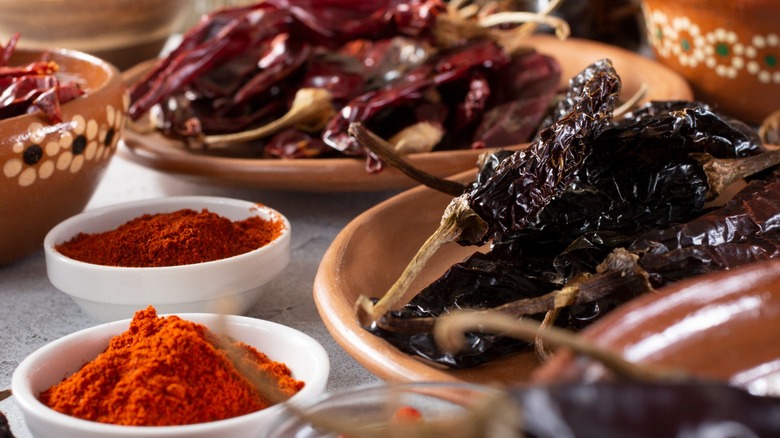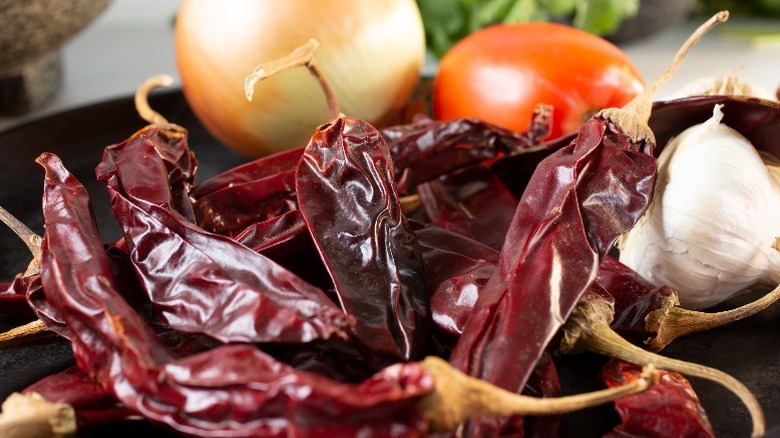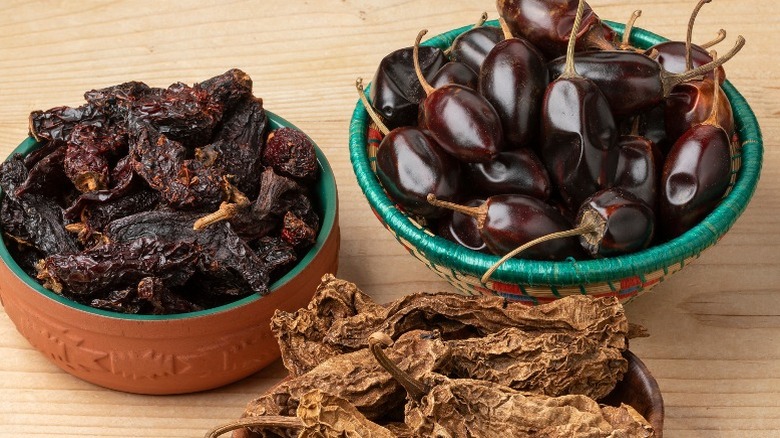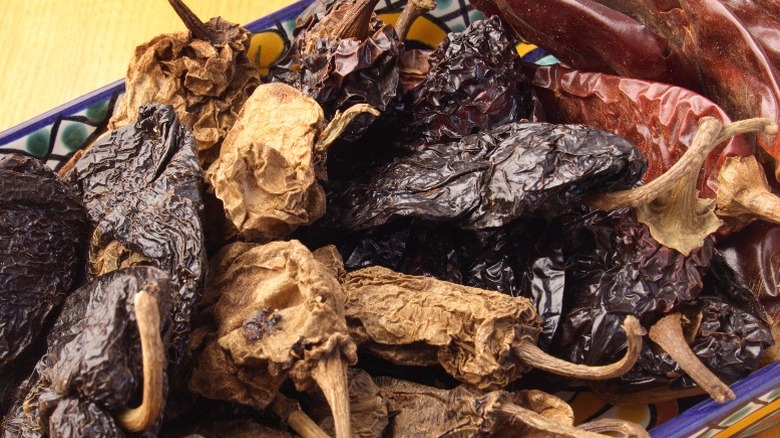Light Vs Dark Chiles: What Sets Their Flavors Apart?
In the world of fruits, few ingredients are more enthralling than peppers. There are so many different kinds it's difficult for botanists to quantify the precise number — estimates report that thousands of pepper varieties exist. What's clear is that humans love cultivating the plant that emerged from the Americas and spread worldwide. And one of the easiest ways to always have what you need on hand is to keep a variety of dried chiles on hand.
But such a dizzying range results in difficulty categorizing the plant in culinary terms unless it's a specific common variety like chipotle or Anaheim. Any guide to hot peppers, no matter how comprehensive, is bound to leave some out. And few focus on dried peppers alone, despite the seemingly endless possibilities available at Latin American grocery stores across the United States, making the options feel overwhelming.
Unless you're well-versed in the intricacies of ancho versus pasilla, navigating the nuances can feel intimidating. So to aid culinary usage, chefs may delineate dried chiles into light and dark. By just glancing at the color, it's possible to guess at the flavors: The lighter hues pack in tangier, brighter notes, while the darker ones have a sweeter and richer flavor.
Light chiles provide vibrant flavors
When it comes to dried chiles, most light-colored varieties are predominantly red, but with varying hues of brown, bright red, or burgundy. Generally, such chiles offer bright flavors with notes that lean fruity, smoky, earthy, or nutty, depending on the variety. Light chiles often contain an undertone of acidity.
What's not constant is the level of heat: Tiny pequins are flavor-packed fiery peppers, while guajillos are generally sweet with acidic notes. Popular chipotles are middle-of-the-pack, celebrated for the smoky notes that arise by way of their processing over fire. Meanwhile, chiles de árbol provide nutty, earthy undertones without shying away from spice. As a rule of thumb, remember that the smaller the pepper, the higher the heat. So for a tasty all-around option, settle on a medium-size light-colored pepper for a balanced combination of flavor, spice, and acidity.
Expect more savory, sweet notes with dark chiles
Dark peppers are easy to spot. Their color is a saturated black, brown, or purple — a quality that can be intentionally highlighted in recipes like mole or adobo negro. Additionally, such peppers tend to consist of thicker, chewier skin, although that alone doesn't influence the categorization. The flavor of these darker chiles resembles other dried fruits, with notes of raisins and prunes as well as smoky notes. Compared to light chiles, most peppers in this category aren't too spicy, although some may come with a small kick.
Many of these peppers are the dried varieties of larger chilies at different states of ripeness. For instance, anchos are dried red-ripened poblanos, with the pepper offering a nice mix of smoky, spicy, and fruity flavors. Mulatos are processed from the same pepper ripened even longer, lending them richer chocolate notes. Meanwhile, both pasilla peppers and chiles negros offer more raisin-like flavors. And if you're after a different sort of dried fruit flavor, then cascabels offer flavors reminiscent of dried apricot with a subtle nutty undertone. As with light chiles, there's a lot of nuance, but expect more general sweetness with dark chile varieties.
Each style comes with go-to culinary applications
With such different flavor options, it's no surprise the two pepper types come with distinct culinary applications. Depending on the application, the peppers may be toasted and are often soaked, creating an aromatic pulp that readily meshes with other ingredients.
The fruity complexity of dark chiles makes them a popular candidate for mole. In a similar vein, such varieties are also integrated into marinades and stews, often used for their body to enhance consistency. Expect to find these chiles in salsa: The vibrant fruitiness of cascabel and ancho are a popular pick. In fact, the sweet quality of dark chiles means you may even find them in desserts — Joanna Gaines gives pecan pie a spicy twist with ancho chile.
Light chiles bring a more dominant vibrancy and spice. As a result, such varieties often function as a heavier accent to a dish. Puya peppers are commonly used as the base of menudo, while guajillos comprise the sauce that tops tortas ahogadas (aka "drowned sandwiches"). And the malleable chiles de árbol contribute a distinct kick to simmered enchilada sauce. As with dark dried peppers, light chiles make for a range of delicious salsas, solidifying their versatility, though you can also get the best of both worlds by using both, especially in intricate dishes like moles, stews, and salsas in which you're looking for chiles to deliver a uniquely complex result.



